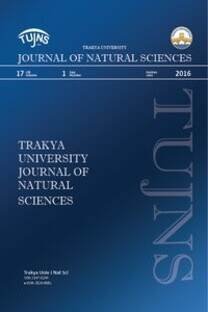Ornithogalum umbellatum L. soğanlarının fitokimyasal incelenmesi ve ham ekstrenin antimikrobiyal aktivitesi
Bu çalışmada Edirne civarından toplanan Ornithogalum umbellatum L. soğanlarındaki kimyasal bileşikler izole edilmiştir. Soğanların kloroform (CHCl3) ve CHCl3:C2H5OH (2:1) ekstrelerine, kromatografîk yöntemler uygulanarak ayırma ve saflaştırma işlemleri yapılmıştır. Bitkiden izole edilen maddelerin UV, IR, NMR ve FAB- Mass spektrumları alınarak kimyasal yapıları belirlenmiştir. Kimyasal yapısı belirlenen bileşiklerden l-(2-metil-undekanil)-2-(3-metil-heptil)-benzen dikarboksilli asit diesterinin spektroskopik yapı analizi burada sunulmaktadır. Aynca, soğanların, kloroform ve metanol ile ekstraksiyonu sonucu ele geçen ham ekstreler birleştirilerek bunun antimikrobiyal aktivitesi araştırılmıştır. Ham ekstrelerin denenen konsantrasyonlarda Bacillus subtilis'in üremesini inhibe etmediği, Enterococcus faecalis ve Candida albicans için daha zayıf etkili olduğu saptanmıştır. Gram-negatif basillere karşı etkilerinin ise değişken olduğu bulunmuştur.
Phytochemical investigation of the bulbs of Ornithogalum umbellatum L. and antimicrobial activity of its raw extract
In this study, Ornithogalum umbellatum L. growning around Edirne has been phytochemically investigated. Choloroform (CHCl3) and CHC13:C2H5OH (2:1) extracts of the plant bulbs were seperated and purificated by using chromatographic methods. The chemical structures of the isolated four compounds from plant were elucidated by using UV, IR, NMR and FAB-Mass spectroscopies. One of them, l-(2-methyl-undecanyl)-2-(3-methyl-heptyl)-benzenedicarboxlic acid diester , was shown below. In addition, CHCl3, and CH3OH raw extract of tile bulbs were combined and then was investigated for its antimicrobial activity. The raw extract at test concentrations did not inhibit growth of Bacillus subtilis, it was more effective relatively to gram-positive coccus excluding Enterococcus faecalis. For Enterococcus faecalis and Candida albicans, it was determinated to be the least effective. For gram-negative bacils, it showed that extract was variable effective.
